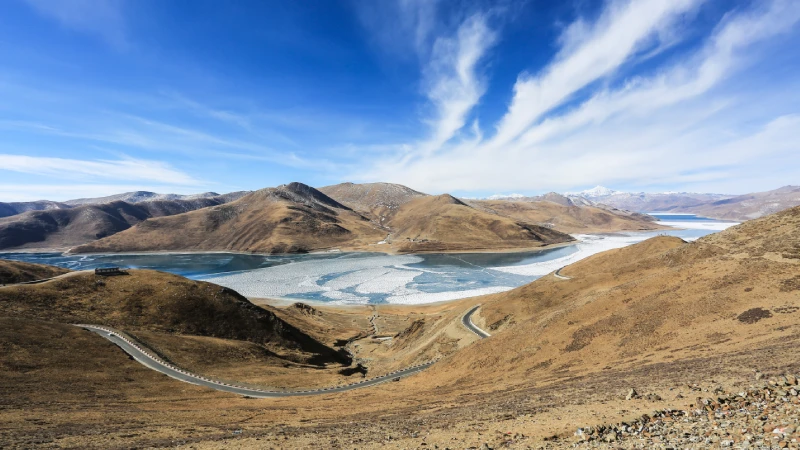Pangong Tso, or Pangong Lake, is one of the most iconic and photogenic destinations in Ladakh. Its crystal-clear blue waters, surrounded by rugged mountains and ever-changing colors, make it a paradise for photographers. Whether you’re a professional or an amateur, capturing the beauty of Pangong Lake requires careful planning and the right techniques. In this guide, we’ll share everything you need to know to take stunning photos of Pangong Lake in 2025, from the best times to shoot to essential gear and composition tips.
Why Pangong Lake is a Photographer’s Dream
Pangong Lake, located at an altitude of 4,350 meters, is a high-altitude lake that stretches across the India-China border. Its unique features include:
- Changing Colors: The lake’s color shifts from deep blue to turquoise and even green, depending on the light and weather.
- Reflections: The calm waters create mirror-like reflections of the surrounding mountains and sky.
- Dramatic Landscapes: The stark contrast between the blue lake and the barren mountains makes for striking compositions.
Best Time to Visit Pangong Lake for Photography
1. Summer (May to September)
- Why Visit: The weather is pleasant, and the roads are accessible.
- Photography Highlights: Clear skies, vibrant colors, and opportunities for sunrise and sunset shots.
2. Winter (November to February)
- Why Visit: The lake freezes, creating a surreal, icy landscape.
- Photography Highlights: Unique shots of the frozen lake and snow-covered surroundings.
Essential Photography Gear for Pangong Lake
- Camera: A DSLR or mirrorless camera with manual controls.
- Lenses:
- Wide-angle lens (16-35mm) for landscapes.
- Telephoto lens (70-200mm) for capturing distant details.
- Tripod: Essential for long exposures and stable shots.
- Filters:
- Polarizing filter to reduce glare and enhance colors.
- Neutral Density (ND) filter for long exposures.
- Extra Batteries and Memory Cards: The cold weather can drain batteries quickly.
- Lens Cleaning Kit: Dust and wind are common, so keep your lenses clean.
Top Photography Spots at Pangong Lake
1. Spangmik Village
- Why It’s Great: Offers a panoramic view of the lake and surrounding mountains.
- Best Time to Shoot: Sunrise or sunset for soft, warm light.
2. Lukung
- Why It’s Great: Known for its calm waters and stunning reflections.
- Best Time to Shoot: Early morning when the water is still.
3. Maan Village
- Why It’s Great: A less crowded spot with unique rock formations.
- Best Time to Shoot: Late afternoon for dramatic shadows.
Photography Tips for Pangong Lake
1. Capture the Changing Colors
- How to Do It: Visit the lake at different times of the day to capture its shifting hues.
- Pro Tip: Use a polarizing filter to enhance the colors and reduce glare.
2. Use Reflections to Your Advantage
- How to Do It: Shoot during calm weather when the water is still.
- Pro Tip: Position your camera low to the ground to emphasize the reflections.
3. Experiment with Long Exposures
- How to Do It: Use an ND filter to slow down the shutter speed and create smooth, dreamy water effects.
- Pro Tip: Use a tripod to keep your camera steady during long exposures.
4. Include Foreground Elements
- How to Do It: Add rocks, flowers, or other natural elements to create depth and interest.
- Pro Tip: Use a wide-angle lens to include both the foreground and the vast landscape.
5. Shoot During Golden Hour
- How to Do It: Arrive early for sunrise or stay late for sunset to capture the warm, soft light.
- Pro Tip: Use a graduated ND filter to balance the exposure between the bright sky and darker landscape.
Astrophotography at Pangong Lake
Why It’s Perfect for Astrophotography
Pangong Lake’s remote location and clear skies make it an ideal spot for capturing the Milky Way and star trails.
Tips for Astrophotography
- Gear: Use a wide-angle lens with a fast aperture (f/2.8 or lower) and a sturdy tripod.
- Settings: Set your camera to manual mode with a high ISO (1600-3200) and a slow shutter speed (15-30 seconds).
- Timing: Shoot during a new moon for the darkest skies.
Personal Experience: Capturing the Magic of Pangong Lake
During my last visit to Pangong Lake, I woke up at 4 AM to capture the sunrise. The cold morning air was biting, but the sight of the first rays of sunlight hitting the lake made it all worth it. The colors of the lake changed from deep blue to turquoise, and the reflections of the mountains were simply magical. I used my wide-angle lens to capture the vastness of the landscape and a polarizing filter to enhance the colors. It was a moment I’ll never forget, and one that I was able to capture perfectly with my camera.
FAQs About Photography at Pangong Lake
1. What is the best time to visit Pangong Lake for photography?
The best time is from May to September when the weather is pleasant and the roads are accessible.
2. Can I use a drone at Pangong Lake?
Drone usage is restricted in certain areas. Always check local regulations and obtain necessary permits before flying a drone.
3. How do I protect my camera from the cold?
- Keep your camera and batteries warm by storing them close to your body when not in use.
- Use weatherproof covers to protect your gear from dust and wind.
4. Are there accommodations near Pangong Lake?
Yes, there are campsites and guesthouses near Spangmik and Lukung villages.
Conclusion
Pangong Lake is a photographer’s paradise, offering endless opportunities to capture stunning landscapes, vibrant colors, and unique moments. By following this guide, you’ll be well-prepared to make the most of your photography adventure at Pangong Lake in 2025. Remember to respect the local environment, stay safe, and most importantly, enjoy the process of capturing the beauty of this incredible destination.

